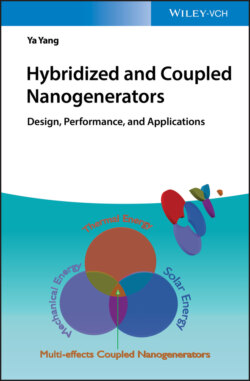Читать книгу Hybridized and Coupled Nanogenerators - Ya Yang - Страница 12
1.2.1 Hybrid Energy Cells
ОглавлениеIn 2009, mechanical and solar energies have been reported to be scavenged with a hybrid device by using a piezoelectric nanogenerator at the bottom surface and a dye‐sensitized solar energy harvester at the top surface of the device [7]. The output voltage of the solar energy harvester can be about 0.591 V and the output current density can be about 6.9 μA/cm2. When the piezoelectric nanogenerator is working, the increased output voltage can be about 0.6 V and the output current density still remains at a fixed value, where the enhancement of the voltage is due to the piezoelectric nanogenerator [7]. By integrating a piezoelectric nanogenerator, the used dye‐sensitized solar energy harvester has been also utilized to create a hybrid energy cell for concurrently scavenging solar and mechanical energies [24]. The corresponding output voltage of the solar cell was found to increase from 0.415 to 0.433 V due to the piezoelectric nanogenerator.
From 2011 to 2014, various hybrid energy cells were reported to scavenge multi‐types of energies at the same time for realizing the enhancement of the conversion efficiency of the related energy devices, exhibiting practical applications in sensor networks and electrochemical reactions. In 2013, Yang et al. reported a hybrid energy cell consisting of a TENG and a micropyramid Si solar cell, which can be utilized to scavenge mechanical and solar energies at the same time [25]. As displayed in Figure 1.1a, the working of the TENG is due to the periodical contact and separation between the indium tin oxide (ITO) film and the polydimethylsiloxane (PDMS) nanowires. The fabricated solar cell consists of Si‐based micropyramid p–n junctions, where the used Si pyramids have sizes ranging from 1 to 10 μm, as presented in Figure 1.1b. The inset of the Figure 1.1b shows the used PDMS nanowires. Figure 1.1c presents the J–V curves of the used solar energy harvester with and without the transparent PDMS nanowires on the surface of the device, where the output voltage of the device can be about 0.6 V and the output current density can be about 35 mA/cm2 under simulated sunlight illumination, respectively. After using the PDMS nanowire array on the solar cell, the corresponding conversion efficiency of the fabricated device was decreased from 16% to 14%. Figure 1.1d nanomaterial displays the V–t curves of the hybrid energy cell, indicating that the rectified output voltage signals of TENGs exhibit DC peak characteristics.
Figure 1.1 Hybrid energy cell for scavenging solar and mechanical energies. (a) Schematic diagram of the designed device. (b) Scanning electron microscopy (SEM) image of the Si pyramid structures. The inset displays an SEM image of the PDMS nanowire array. (c) J–V curves of the solar cell covered with and without PTFE(polytetrafluoroethylene)‐PDMS polymers under a light illumination intensity of 100 mW/cm2. (d) V–t curves of the solar cell, hybrid energy cell, and TENG.
Source: Reproduced with permission from Yang et al. [25]. Copyright 2013, American Chemical Society.
Yang et al. also reported many other hybrid energy cells [26–29], including TENGs, piezoelectric nanogenerators, solar cells, thermoelectric nanogenerators, and pyroelectric nanogenerators. All the hybrid energy cells are based on effectively integrating the multimode energy scavenging units into a system to obtain sustainable power supply. The purpose of developing hybrid energy cells is to maximize the energies obtained from our living environment. How to effectively integrate the different energy scavenging units is still a challenge in practical devices. Moreover, the ratios among different energy scavenging abilities also need to be considered to make sure that this integration is useful in the system.
